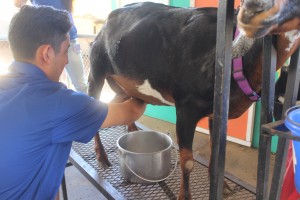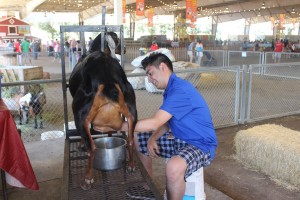When I came in to work this morning, everything was great and peachy. However, after a few minutes in the vicinity, my stomach was tied up in knots and I felt the need to go back to my house and just sleep! The strangest feeling ever – and I had no idea why!
Today seemed like a typical Sunday…I clocked in, said hello to everyone I came across, turned on my computer and checked my email. Normal enough, right?
Well, it wasn’t until one of my coworkers reminded me of my goat-milking session with Stella (goat) that my blood rushed to my hands and feet and I almost fell off my seat!
You see, I love Farm animals, but I’ve always preferred to give them their space and let them carry on with their business.
Since I was worried about hurting the goat, I arrived to an hour earlier to talk to Sarah, the Goat Handler!
 Here are a few things I learned from Sarah’s class:
Here are a few things I learned from Sarah’s class:
- A female goat (aka Doe) produces milk for their babies. Once the babies have been weaned, the mothers need to be milked 1-2 times per day in order to continue producing their milk for the next 10 months of the year.
- The amount of milk produced depends on the size of the goat.

- Temperature of the milk is typically above 100°F – which is body temperature.
- Diet is high in protein — alfalfa hay should be available 24/7. This is what helps their regularity.
- Diet also includes occasional grain mixture (aka goat candy), that includes barley, grains and sunflower seeds.

- Sunflower seeds help produce sweeter tasting milk because of the additional fatty oils.
- Takes about 5-8 minutes to do an average milking.
- Goat milk is stored in mason jars in the freezer. Best if used within 30 days.
- Goat milk can be used to make ice cream and goat cheese too.
***BONUS: Always be gentle when you’re milking a goat and NEVER pull on their teats!
Have you ever milked a goat (or a cow)?
Tell me about your experience in the comment section below.

No Comments